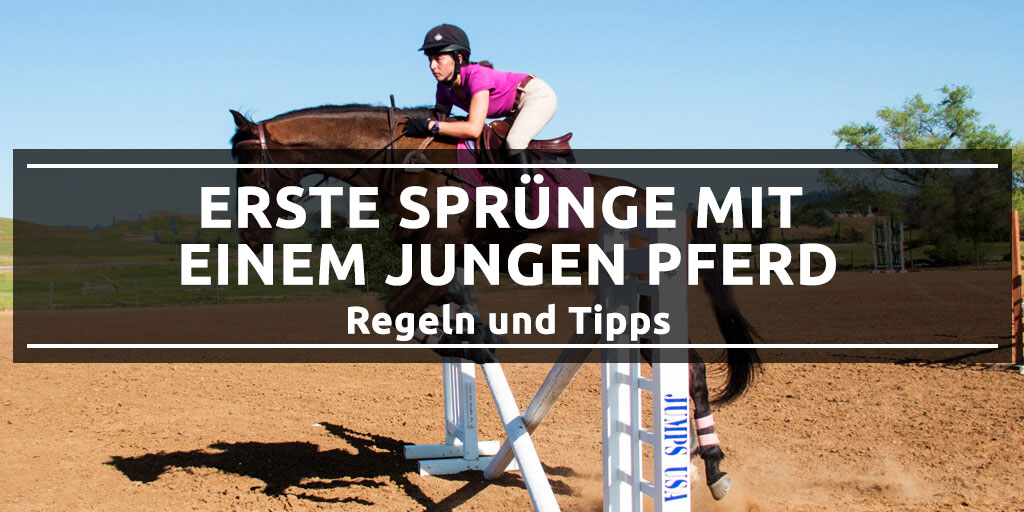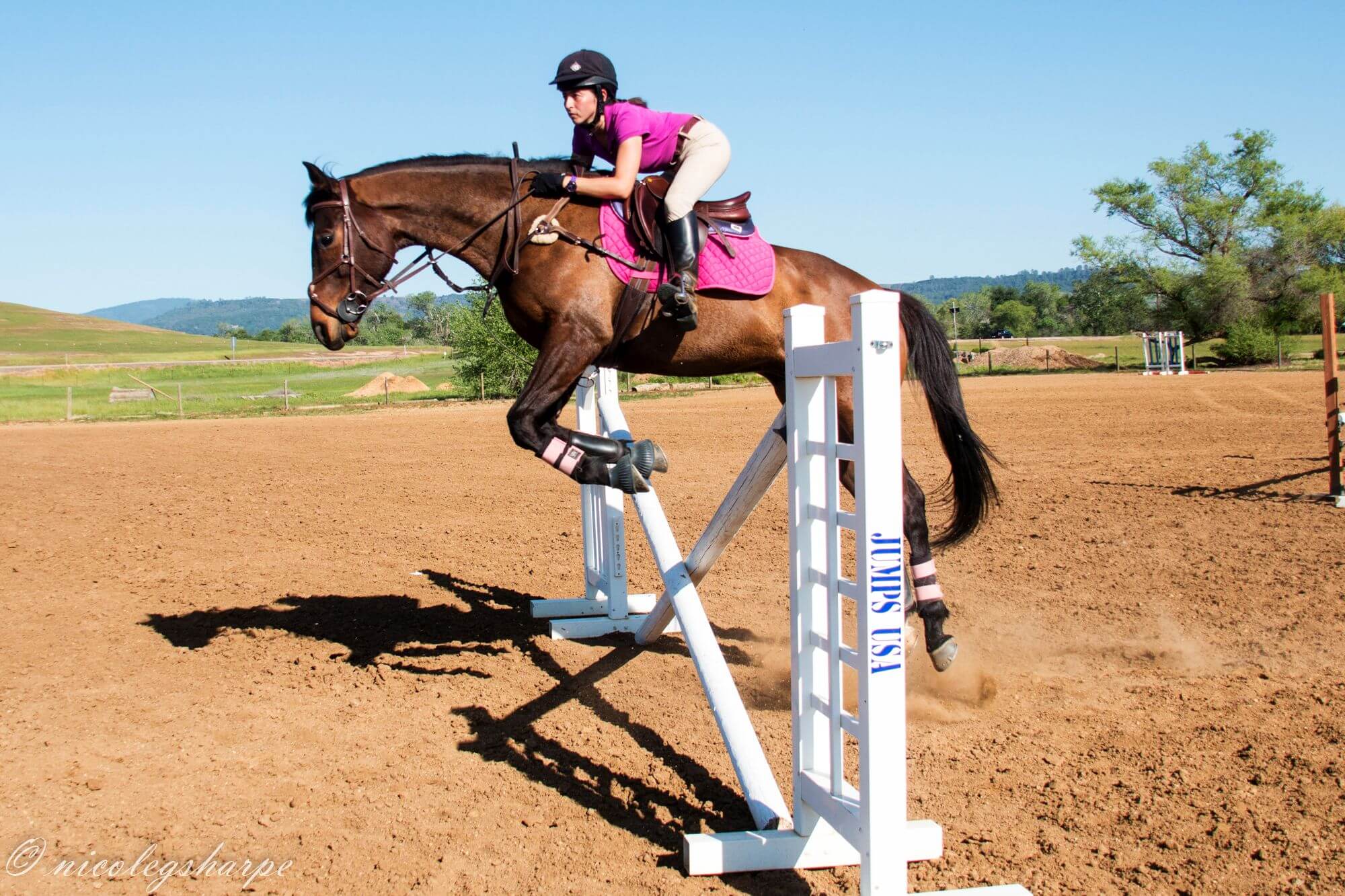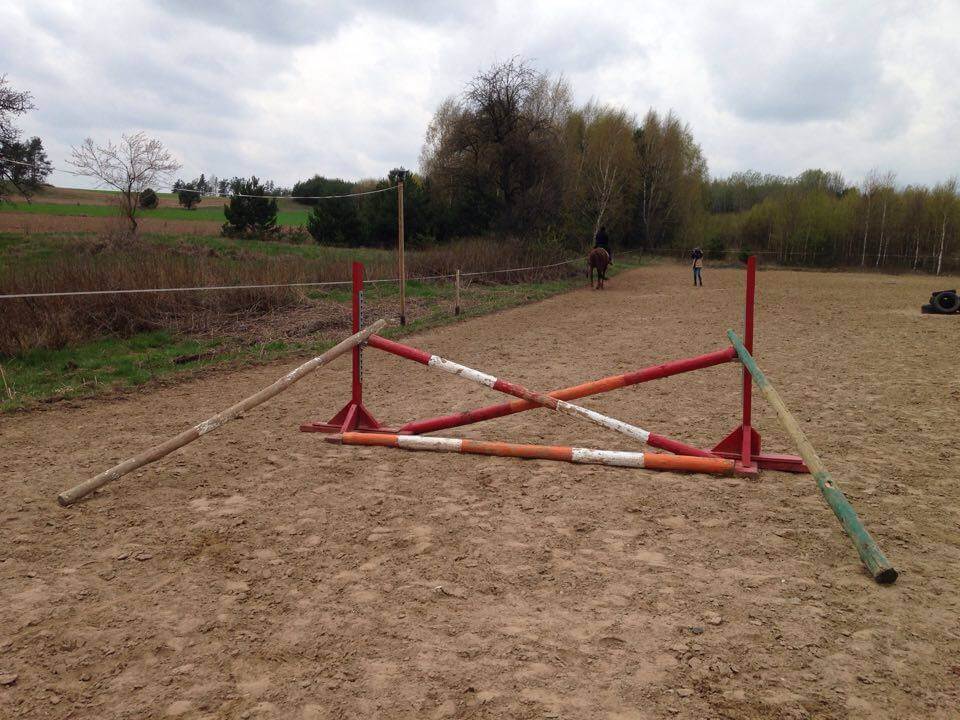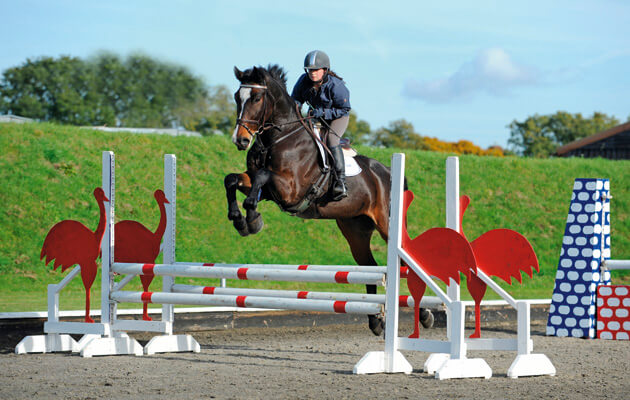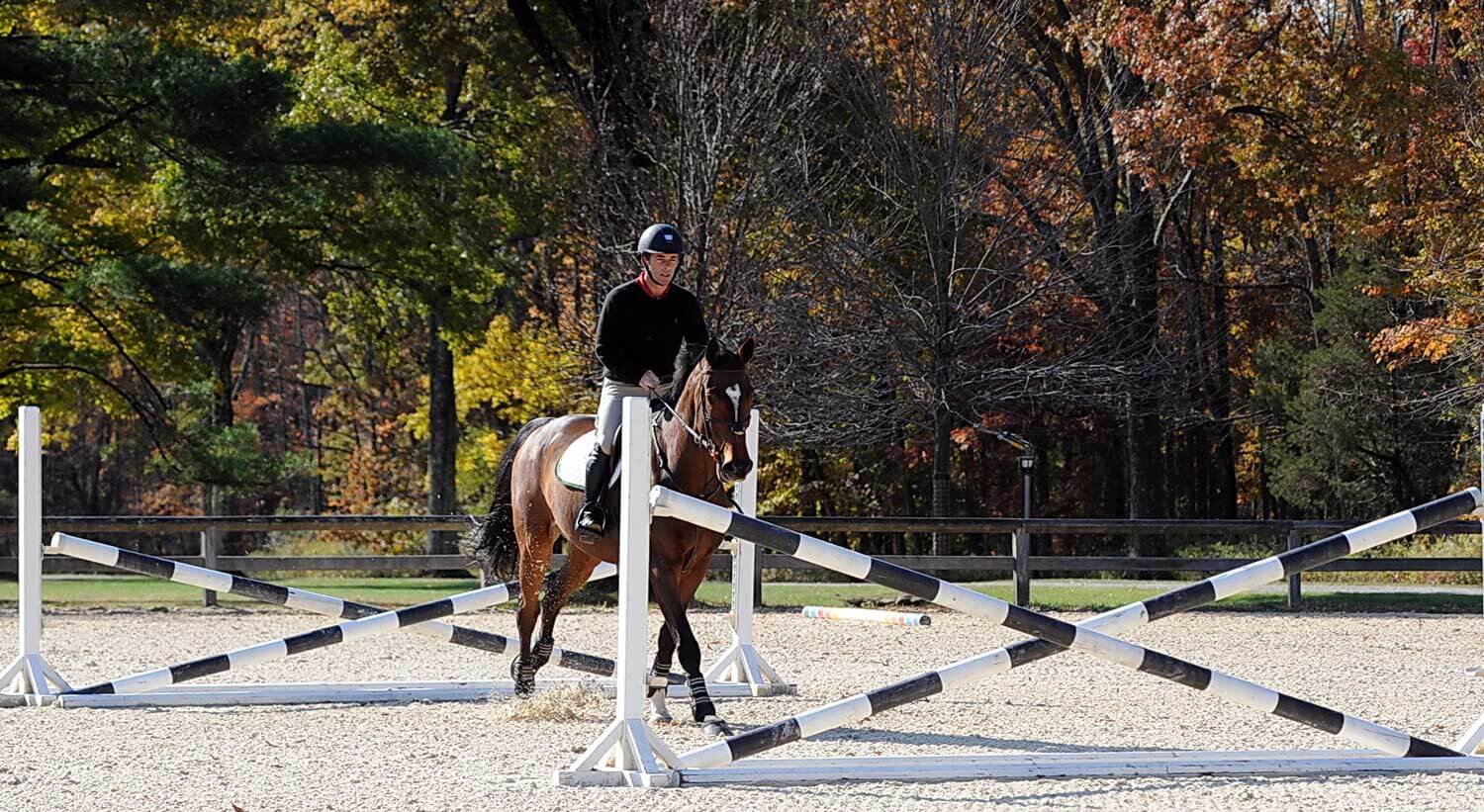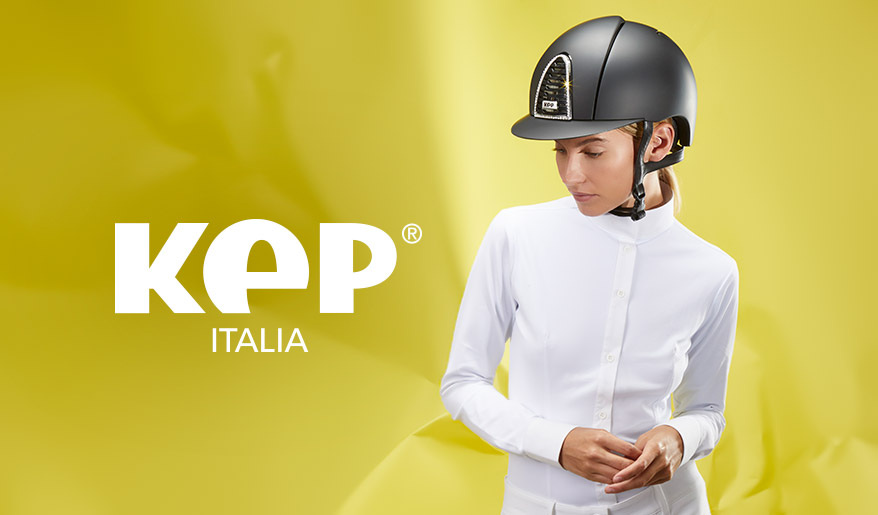Hintergrundquelle: zenbabyhorse.files.wordpress.com
Es ist allen klar, dass die Ausbildung eines jungen Pferdes mehr Wissen und Fähigkeiten erfordert als die Arbeit mit einem bereits ausgewachsenen Pferd. Ein junges Pferd wird aufgrund seiner ersten Erfahrungen mit einem Reiter und jeder gestellten Aufgabe eine bestimmte Reaktionsschnelligkeit, Durchlässigkeit, Disziplin und Vertrauen zum Menschen prägen. Es hängt von uns ab, auf welchem Niveau es jede dieser Fähigkeiten entwickelt. Natürlich hat jedes Tier bestimmte Neigungen und Eigenschaften, die unsere Arbeit zunächst erschweren oder erleichtern können. Es liegt jedoch an uns, ob sie zu seinen Vor- oder Nachteilen werden. Zum Beispiel: Wenn das Pferd sehr energisch ist und wir ihm von Anfang an beschleunigen lassen, wann immer es will, wird „ein Pferd wie von der Rennbahn“ immer unser Problem sein. Und wenn wir seine Energie beherrschen, können wir jede Übung von ihm dynamisch, mit vollem Einsatz, aber auch in einem von uns vorgegebenen Tempo ausführen lassen.
1. In kleinen Schritten zum Ziel
All dies gibt uns große Kraft, das Pferd zu beeinflussen – positive oder im Gegenteil – negative Reaktionen bei ihm aufzubauen. Daher ist es wichtig, dass jedes Training gut durchdacht ist. Versuchen Sie, sich an das Prinzip der „kleinen Schritte“ zu halten, indem Sie häufige, wenig intensive Unterrichtsstunden einführen und Ihrem Tier viel Zeit geben, neue Anforderungen und Fähigkeiten zu erlernen. Man sollte im Training Monotonie vermeiden und darauf achten, dass das Pferd immer zufrieden vom Reitplatz kommt, dass es unsere Erwartungen erfüllt hat (das Training erfolgreich abgeschlossen hat).
2. Lassen Sie es alles kennenlernen
Bevor wir mit einem jungen Pferd ans Springen gehen, sollten wir es zuerst mit den Hindernissen vertraut machen. Wir müssen mit dem Tier zum gebauten Rick gehen und es daran schnüffeln lassen. Wir können es vor dem Ausritt machen, das Pferd an der Hand führen oder in der Anfangsphase (Entspannungsphase) des Trainings auf dem Rücken sitzen.
3. Springen ist der einzige Weg
Bei den ersten Sprüngen mit unserem "Neuling" lohnt es sich, sich an die Grundregel zu erinnern: Es gibt keine andere Möglichkeit, ein Hindernis anzureiten, als zu springen. Von Anfang an sollte das Pferd nur eine Lösung lernen - springen, ohne die Möglichkeit, vor einem Hindernis anzuhalten oder auszubrechen. Daher müssen wir uns darauf einstellen, dass dieser Sprung immer ausgeführt werden muss. Dabei spielt es keine Rolle, ob im Schritt oder aus dem Stand. Die ersten Anritte auf ein Hindernis können mit Hilfe eines führenden Pferdes durchgeführt werden, hinter dem unser Pferd folgt. Wir sollten auch daran denken, dass es ratsam ist, die Stimme zu verwenden, insbesondere bei ängstlichen Pferden - es wird sie motivieren, das Hindernis zu überwinden.
Wenn das Pferd den einzigen und richtigen Weg kennt, wird es das Vergnügen haben zu springen und es bereitwillig tun. Dank dessen wird es nicht versuchen, nach anderen Lösungen zu schauen. Es wird für ihn offensichtlich werden, den Sprung zu machen, und nicht nur eine Notwendigkeit.
Quelle: zenbabyhorse.wordpress.com
4. Nur ein Hindernis
Wir müssen mit kleinen Hindernissen beginnen, die unser Pferd nicht erschrecken und seine körperlichen Fähigkeiten nicht übersteigen. Bei der Planung der Hindernishöhe müssen wir sogar den erwähnten Sprung vom Stand berücksichtigen. Üben Sie am besten auf einem 30-40 cm hohen Rick. Die Stange auf Cavaletti funktioniert etwas schlechter, weil das Tier aufgrund früherer Erfahrungen versuchen wird, daran vorbeizukommen.
Wir springen nur ein Hindernis und das im Trab. Wieso? Denn mit dem Galoppieren ist noch eine weitere Fähigkeit verbunden – das Messen der Sprungkraft, und wir wollen das Tier nicht in einer völlig neuen Situation behindern. Wenn Sie im Trab reiten, ist es auch einfacher, das Tempo beim Aufreiten auf ein Hindernis zu kontrollieren.
Rick mit Hinweis und Fang
Wir können dem eingestellten Rick einen Hinweis auf dem Boden hinzufügen (der 30 cm über das Hindernis hinausragt). Außerdem funktionieren Fänge gut – zwei diagonal aufgestellte Stangen, deren eines Ende gegen das Hindernis und das andere gegen den Boden gelehnt wird.
Der Rick ist das perfekte Hindernis zum Springen lernen, denn die sich kreuzenden Stangen markieren die Mitte des Hindernisses, was den Pferden unwillkürlich die richtige Stelle zum Springen beibringt – mitten durch. Die Vorderseite des Ricks sollte mindestens 3,50 m breit sein.
Es ist eine gute Idee, das Hindernis in Richtung des Ausgangs zu platzieren, einige Meter hinter der Ecke und vorzugsweise neben der Grenze - dadurch spielt der Zaun die Rolle einer der Fänge. Diese Anordnung begrenzt das Pferd natürlich von den Seiten und führt zum Hindernis. Darüber hinaus erlaubt ihm das Vorhandensein einer Ecke nicht, zu beschleunigen, was einige schlechte Angewohnheiten und Fehler ausschließt, die das Pferd beim Aufreiten eines Hindernisses begehen kann.
Es hat keinen Sinn, in der ersten Phase des Springen Lernens mehr als ein Hindernis zu machen. Das Pferd hat sowieso ein Probleme genug, um ein Hindernis richtig zu überspringen - mehr kann seine Angst und Zurückhaltung nur verstärken. Was bedeutet „erste Lernphase“? Dies ist ein relatives Konzept – je nach Pferd kann es mehr oder weniger Zeit in Anspruch nehmen. Genauer: Es dauert so lange, bis das Tier lernt, ohne nachzudenken, gleichmäßig und souverän das Hindernis zu überwinden.
Übrigens ist es erwähnenswert, dass selbst erfahrene Pferde Fehler beim Springen über einzelne Hindernisse (oder möglicherweise Reihen) besser korrigieren als das Springen des gesamten Parkours. Wieso? Aus einem einfachen Grund: Wenn wir ein Hindernis überspringen, haben wir die Möglichkeit, einen Moment nachzudenken und Fehler zu analysieren, bevor wir erneut springen. Außerdem können wir nach jedem Sprung eine kurze Pause machen, wodurch das Pferd nicht zu schnell ermüdet und wir mehr Wiederholungen machen können.
5. Der Reiterkörper ist der Hauptlehrer
Gerade bei den ersten Sprüngen hat das Körperverhalten des Reiters einen großen Einfluss auf das junge Pferd. Unser Fehler kann für die Zukunft negative Assoziationen für das Pferd wecken. Denken Sie also daran, beim Springen sanften Kontakt mit dem Maul zu halten. Wenn das Pferd vor einem Hindernis stoppt, was das Pferd zum Springen aus dem Stand bringt, oder wenn das Tier kurz vor dem Sprung den Kopf wirft, müssen wir schnell die Mähne greifen oder sich am Hals stützen. Dadurch vermeiden wir einen starken Ruck an der Zügel und bleiben in einem solchen Gleichgewicht.
Während des Sprungs sollten wir versuchen, unsere Hände in Richtung Halskamm zu legen, aber seien Sie vorsichtig, ob wir dies nicht zu schnell tun. Lockern wir die Zügel zu schnell, fühlt sich das Tier allein gelassen. Unsere Hand darf auch nicht „hart“ sein, das heißt steif und widerstandsfähig gegen den Mauldruck. Wieso? Weil das Pferd das wissen muss, dass wir ihm über dem Hindernis die Möglichkeiten lassen, sich zu strecken, seinen Rücken zu runden und seinen Hals zu verlängern.
Keine lockere Zügel und die rückwärtig arbeitende Hand führen zu einem Mangel an Dehnung, Rundung des Rückens und keiner Verlängerung des Pferdehalses, Quelle: keyassets.timeincuk.net
6. Wir haben den Rick gesprungen und was kommt weiter?
Nach dem Sprung durch das Rick aus dem Trab können wir zu den nächsten Hindernissen übergehen - immer noch auf einer Höhe von 30-40 oder 50 cm (je nach Körpergröße des Pferdes) sowie dem Hinweis, Fang und Positionierung hinter der Ecke am Rand. Wir können das Rick gegen eine Staccionata tauschen. Wenn sich auch das Pferd daran gewöhnt hat, sollte man sie durch einen Oxer ersetzen, der am besten einen verlängerten Hinweis haben sollte, der sich kurz vor der ersten Stange des Hindernisses befindet. Außerdem ist es gut, wenn beide Oxerstangen auf gleicher Höhe liegen oder wenn die zweite Stange höher liegt als die erste.
In der nächsten Lernphase sollte man auch versuchen, an verschiedenen Stellen des Reitplatzes Hindernisse aufstellen und den Fang langsam aufgeben. Nach der Phase des Springens über verschiedene Arten von Hindernissen können wir in niedrige Reihen einsteigen, während wir immer noch aus dem Trab springen.
Denken Sie jedoch daran, dass wir diese "Etappen" nicht während einer Trainingseinheit durchlaufen und absolvieren werden. Es hängt alles vom Pferd ab. Lassen wir ihm so viel Zeit, wie es braucht – damit es sich sicher fühlt und das Springen über gewisse Hindernisse kein Problem mehr für das Pferd ist.
7. Die erste Gymnastikreihe
Hinter der Kurve, an der längsten Wand beim Reitplatzzaun stellt man drei Cavaletti zum Trab auf (Abstand: ca. 1,20-1,40 cm). All dies, um ihre Mitte zu treffen, nachdem man über die lange Wand geritten ist. Das Pferd sollte die Cavaletti ohne Beschleunigung in beide Richtungen schaffen und sich in einem gleichmäßigen Tempo bewegen. Gelingt uns das, können wir das Rick im Abstand von 2,20 m von letzter Cavaletti und wieder einen Fang aufstellen (der Zaun des Platzes dient als zweiter Fang).
Nach ein paar Sprüngen können wir die Stange in 3 Metern Entfernung hinter das Rick auf den Boden legen, durch das das Pferd den ersten Galopp machen wird. Dann kann die Stange in einen Rick verwandelt werden und wir können 2-3 mal die Reihe hintereinander springen. Für jedes der gebauten Hindernisse können wir einen Fang von der Seite der Mitte des Reitplatzes hinzufügen.
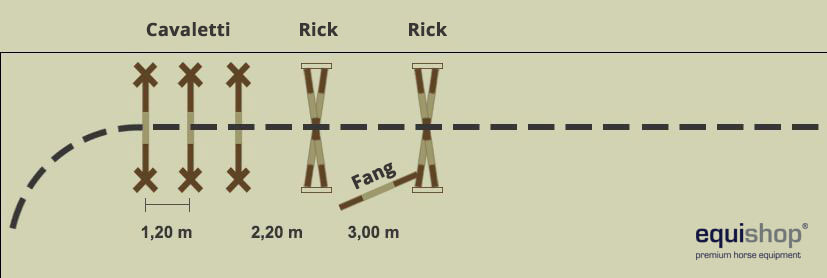
Legen Sie in den nächsten Schritten die Stange auf dem Boden hinter das andere Rick, wieder in einem Abstand von 3 Metern, die sich dann in einen Rick verwandelt. Drei Hindernisse hintereinander reichen für ein junges Pferd. Wir können es jedoch kombinieren, indem wir zum Beispiel das zweite und dritte Hindernis durch eine Staccionata ersetzen und am Ende das letzte in einen Oxer verwandeln.

Wenn das Tier auf Cavaletti beschleunigt und das erste Rick zu schnell überwindet, setzen Sie die Cavaletti in die Kurve ein oder machen Sie einen kürzeren Anritt aus der Kurve.
Wenn das Pferd langsamer wird, Energie verliert oder keine Lust hat, sollte man es von einer Kurve entlang einer kurzen Wand zur nächsten Kurve galoppieren, in der wir mit der gewonnenen Energie im Galopp in den Trab und zur Cavaletti gehen.
Es gibt keine goldene Regel, die besagt, wie oft wir in einer bestimmten Kombination springen können, indem wir die Reihe erweitern. Es wird davon ausgegangen, dass 2-3 Sprünge ausreichen sollten, bevor ein weiterer Elemente ersetzt / hinzugefügt werden, dies ist jedoch keine Regel. Wir erinnern Sie daran: Jedes Pferd ist ein anderer Fall. Wir können es weder körperlich – mit zu vielen Sprüngen noch mental – mit der Monotonie des Trainings erschöpfen lassen. Das Pferd sollte die Arbeitsphase zufrieden beenden = gute Ausführung der Übung.
Nach einem solchen Training in der ersten Reihe sollte man dem Pferd eine Pause gönnen - auch für 2-3 Tage und dann wieder zum Training auf Hindernissen zurückzukehren.
Quelle: practicalhorsemanmag.com
8. Weitere Arbeit in der Reihe und Linie
Der nächste Schritt könnte darin bestehen, eine Reihe zu erstellen (beginnend mit Cavaletti und einem Rick), aber in einer neuen Konfiguration, die es dem Tier ermöglicht, sich leicht zu strecken und die Länge des Foules zwischen Hindernissen zu manipulieren. Die zwischen den Hindernissen platzierten Cavaletti oder Stangen sind hilfreich, um die Foules zu messen.
In den nächsten Schritten können wir versuchen, die dem Pferd bereits bekannten Reihen an neuen Stellen zu platzieren: auf der Mittellinie des Reitplatzes und der Diagonalen. Sie sollten wieder so aufgebaut werden, dass man mit drei Cavaletti und einem Rick beginnt.

9. Springen aus dem Galopp
Lassen Sie Sprünge aus dem Galopp zur letzten Phase unseres Trainings werden, direkt nach den obigen Reihen mit Cavaletti aus dem Trab. Wieso? Dies verhindert, dass das Tier während des Anreitens an Tempo verliert und beschleunigt, und hilft dem Tier auch, die Sprungposition in der Reihe selbstständig zu messen, die es später - während der Galoppanritte auf das Hindernis - verwenden kann. Nach der Reihenphase können wir versuchen, das Training noch einmal zu durchlaufen (wie beim Trab), beginnend mit einem einzigen Rick, dieses Mal aber alle aus dem Galopp. Bei Galoppspringen lohnt es sich, vor dem Hindernis einen Hinweis aufzustellen (die Entfernung zum Hindernis finden Sie HIER in der Tabelle). In der Endphase können wir auch versuchen, ohne Hinweis zu springen.
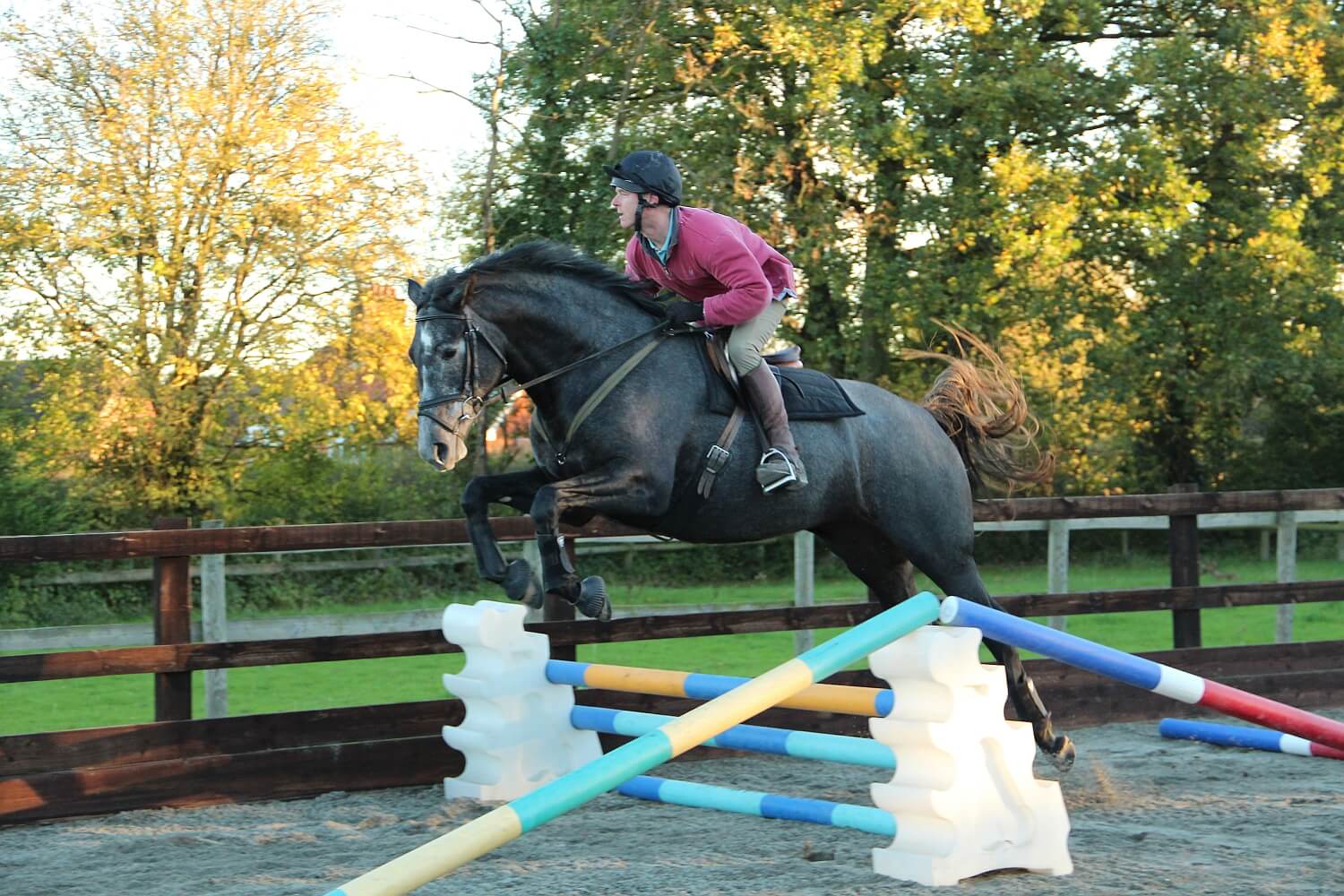
Ein Sprung aus dem Galopp mit einem Hinweis vor einem Hindernis. Staccionata am Zaun mit Fang, die von der Seite des Platzes abgrenzen. Reiter - zu steife Hand, zu wenig Bewegung mit den Händen in Richtung Halskamm, Quelle: janinelamy.wordpress.com
10. Wann sollen wir das Hindernis heben?
Warum haben wir bisher nichts über das Heben der Hindernisse erwähnt? Denn dies macht beim Erlernen der ersten Sprünge nicht viel Sinn. Lassen Sie das junge Pferd zunächst an die Sprünge, das sich bewegende Gewicht des Reiters und die verschiedenen Arten von Hindernissen gewöhnen, die an verschiedenen Stellen des Reitplatzes platziert sind. Lassen Sie es lernen, aus dem Trab und dann aus dem Galopp zu springen. Es sollte die richtige Sprungtechnik entwickeln. Es soll merken, dass es über dem 40-cm-Hindernis keinen Meter Abstand machen muss :)
Das Heben der Hindernisse ist die letzte Stufe, in der das Pferd seine Aktion über ein Hindernis, das es bereits kennt, einfach verstärken muss. Das Tier sollte körperlich darauf vorbereitet sein, solche Hindernisse mit dem Reiter auf dem Rücken zu überwinden. Denken Sie daran, dass das Springen über höhere Hindernisse die Gelenke des Pferdes stärker belastet, insbesondere bei der Landung mit dem Reiter auf dem Rücken. Versuchen wir also, den Moment nicht zu überstürzen, wenn wir anfangen, Meter hohe oder noch höhere Hindernisse zu springen. Der Schaden, den unser junges Pferd erleidet, kann irreversibel bleiben.



